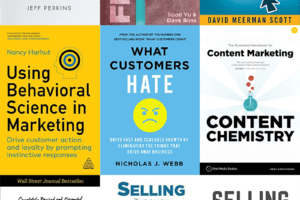???? Episode 97 of Yes, and Marketing
You have to admire someone who isn’t afraid to go against the grain.
On this episode, expect a heavy dose of contrarian (and prescient) insights from our guest, Doug Kessler. After beginning his marketing career at Ogilvy in the ‘80s, Doug jumped ship to focus on B2B marketing and co-founded Velocity, one of the world’s most prestigious B2B tech marketing agencies. He is also a prolific speaker and writer, and—thanks to his knack for spicy takes—he’s one of our Verblio team’s favorite marketers to follow.
In this interview, Doug gets real on everything from marketing agencies to the future of marketing to the problems with content today:
- Why the stakeholder problem isn’t real
- Why vanity metrics are useful
- What’s up with content’s “mountain of meh”
- Why we shouldn’t all be Pollyanna
Listen to the full interview above or read on for our highlights from the conversation. You can also view excerpts from all our episodes on our show page.
???? Guest-at-a-Glance
Name: Doug Kessler
What he does: Co-founder of B2B marketing agency Velocity.
Find Doug on the web: Velocity | LinkedIn | Twitter
Get smart: “Content that can be a digital session, instead of an off-screen consumption like a PDF download, is going to be better.”
???? Four future trends
As an agency partner for some of the top B2B brands in the world, Doug mentioned a few key trends he’s seeing in the world of marketing:
- Accountability
“Agencies have to be more accountable,” Doug says. At Velocity, that has led to “finding the things that will impact the success of our work, and either controlling them by doing them all, or helping the client or their agency do it,” he explains.
“So we can’t just say, ‘Here’s the content, hope you use it.’ We know the whole thing will be judged by, did it work? And a lot of things have to go right for it to work, so we want to help with those.”
“We don’t want to be beholden to a process that we couldn’t be accountable for,” he adds.
- Sessionized content
“Content that can be a digital session, instead of an off-screen consumption like a PDF download, is going to be better,” Doug predicts. Why? Because when you sessionize your content, you can learn exactly what resonates with your audience and what doesn’t. “You can see, did they drop out? When did they drop out? Why did they drop out? And fix it,” he says.
This rise of sessionized content also means that developers will play a more crucial role on content teams than ever before. Doug says, “I think dev is more and more important in any content team. This stuff’s gotta be digital.”
- Web 3.0
What’s Web 3.0? Think blockchains, NFTs, digital ownership, and the like. While it’s not as immediate as his other trends—Doug gives this one closer to a five-year timeline—it’s one to start understanding now.
“Something’s happening,” he says. “You’ve got to have a look at that.” (Want some ideas? He’s got a list to get you started.)
- Ecosystem marketing
“If you’re marketing through Salesforce’s app exchange or HubSpot’s app marketplace, there’s a new world of marketing there,” Doug says. “You got to figure out, what are the merchandising possibilities and discovery possibilities of that platform? How do we max it out?”
He breaks down 3 different facets of ecosystem marketing: marketing yourself through other platforms, getting apps onto your platform (if you’re the Salesforce or Hubspot type), and getting your users to use those apps. “Those are three plays that weren’t around a few years ago, and for some companies are now the number one thing,” he explains. “Some companies live and die by what happens in the Salesforce app store.”
???? Episode highlights
Read verbatim excerpts from our interview with Doug Kessler.
Advice to CEOs
“Find a great CMO, find good marketers, and let them do their job. Let them teach you, let them show you the way. Give them clarity of what you want to do with the business, where you want to bring it, and be honest with your feedback, but still respect the discipline.”
Advice to marketers on handling stakeholders
“Don’t assume they’re good at this stuff and then just bring them ideas for them to judge. You’re better at this than them. You’re a marketer, full-time, so help them out.
I feel like this idea, this mindset of stakeholders as the enemy or the obstacle or the barrier, is really a mistake. Marketers have to own it and say, ‘Look, it’s our job to bring them along.’ Before you bring them an idea, tell them what you’re trying to do. Tell your CEO what’s up and help them see what you’re trying to do. If they agree with what you’re trying to do and how and why, then you’re good. If they don’t, have it out then before you start bringing work to them to judge and to evaluate or edit.
And when you do bring them a piece, say, ‘This is what this is for. Here’s the target audience. Here’s what we’re doing it for. Here’s what it is not.’ Because often you’ll find stakeholders judge a piece for something it’s not even trying to do, and it can die for that reason. That’s a stakeholder alignment problem, not a creative or marketing problem. So get on it.”
Don’t try to do everything in one piece of content
“We talk to our clients a lot about the content mix.
Don’t ask everything to do everything. If one piece just needs to do attitude and brand, celebrate a belief and have fun. Just do that. Don’t then weigh it down with lead gen and the other things. Or if it really wants to teach a point, just do that.”
The mountain of meh
“The bell curve is established now. You’ve got some really terrible stuff down there at the tail, you got some great stuff at this tail, and the middle, the ‘mountain of meh’ I call it, is actually where most ends up, and even if it has merit, it doesn’t signal that merit enough to really get people in there to engage with it.
So in a way, the stock of a piece of content has gone down. It doesn’t confer advantage automatically to you anymore. You’ve got to make it good.”
Why vanity metrics are useful
“Quality is in the eye of the audience, and they’re going to tell you. That’s the definition of it, for me. It’s not, was it beautiful? Was it smart? It’s, did it hit its target? Did it move somebody? And our first metrics are vanity metrics.
We love vanity metrics: likes, shares, reads, downloads—that’s the start, and unless you’re gaming it like buying likes or something, which is stupid, then the vanity metrics ought to correlate with some of the deeper ones that start to move you to revenue.
And revenue is the mother of all metrics. It’s the one you want. The highest quality is the one that made you the most money, but you can’t always measure that directly, instantly, so the vanity metrics are our first ones.”
On opt-in email
“I’m still a really big believer of opt-in email. I think getting people to sign up who want more of your stuff and not abusing that trust and using it well and adding value and earning that, I still think that’s the daddy of it all.
You’ve got to have a good, strong email list, showing people who raised their hand and said, ‘I want more, please.’”
His contrarian marketing advice
“Explore negativity. You know, hate something. There’s this terrible vibe and rule out there in marketing that everything has to be Pollyanna positive, ‘It’s all wonderful, wonderful.’ But that’s not life. There’s plenty to hate. And if you’re not a hateful brand, but you hate the obstacles to your prospect’s success, you know, go ahead and hate.”
????️ Doug Kessler quotes
“I used to feel victimized by the stakeholder problem, and I kind of grew up and realized this is not an obstacle to my job—this is my job. And I gotta get good at it.”
“If you like it, say it. Appreciate somebody. They’ll forgive you a million more things if you just go ahead and appreciate the good stuff.”
“If we can hear the people we’re marketing to, we do better work.”
“Accountability is on the rise.”
“Be the one who’s discovering new ways to tell stories, new ways to do things—and that will make your career a lot more fun, too.”
???? Learn more
Check out a few of Doug’s favorite marketers to follow:
- Andy Crestodina at Orbit Media
- Chris Penn at Trust Insights
- Jay Acunzo at Unthinkable Media
Doug also mentioned Joe Pulizzi’s thoughts on rented and owned land.
Finally, Doug is also a board member with CLEAR Global, an organization helping people get vital information and resources, no matter their language.



